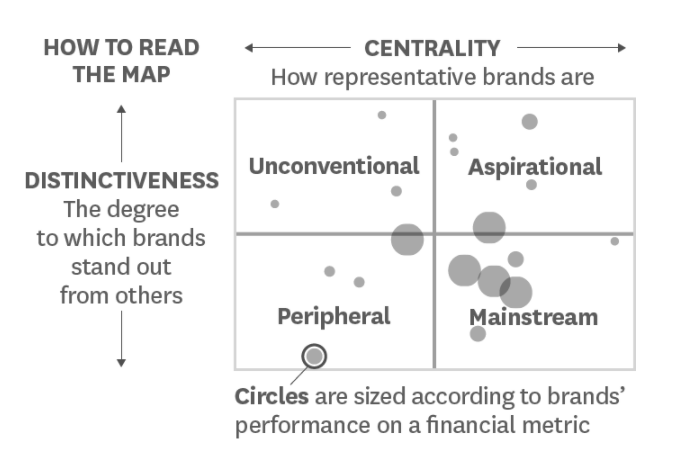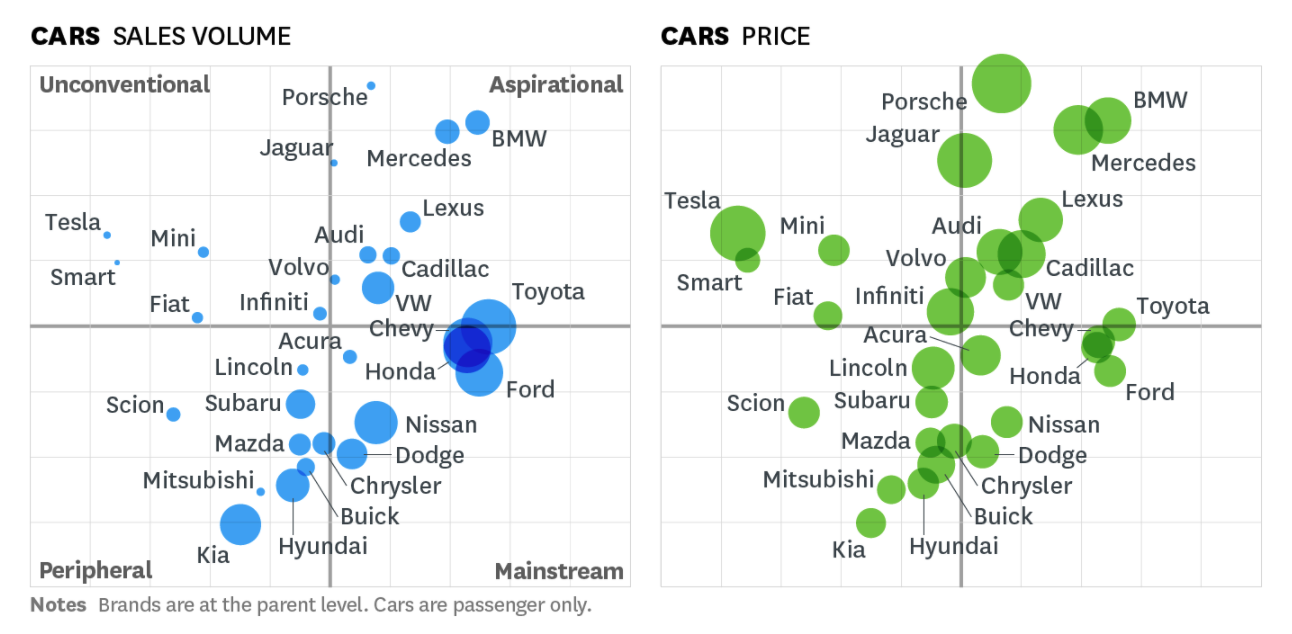📕 subnode [[@houshuang/branding]]
in 📚 node [[branding]]
- #public
-
Defining the product
-
Levitt, T. (1980). Marketing success through differentiation-of anything. Harvard Business Review.
- there is no such thing as a commodity
-
Levitt argues that anything, including a commodity, can be differentiated when it is sold. Write down Levitt's definition of a product in your own words. Also, be sure you can explain the differences amongst: the generic product, the expected product, the augmented product, and the potential product.
-
notes
-
product differentiation
- distinguishable (auto)
-
indistinguishable (detergent)
-
we think that with indistinguishable products like coffee, a tiny difference in price makes the difference - but not so
- Detroit auto steel - grade suppliers on price, flexibility, quality but even new ideas for parts redesign etc
-
we think that with indistinguishable products like coffee, a tiny difference in price makes the difference - but not so
-
product differentiation
-
product
-
definition
- tangible + intangible (symbol, delivery, service, application, knowledge)
- The ‘product’…is the total package of benefits the customer receives when he or she buys.”
-
types
-
generic
- table stakes, the fundamental rudimentary thing
-
expected
- customer's minimal purchase condition - logistics, terms, support
-
augmented
- exceeding the normal expectations
- but is there a process where things that were augmented gradually become expected? Examples of things going in the other direction? (Less luxury with airline flights)
- as seller expands market by teaching customer to use product, becomes more vulnerable to losing them
- product maturity - just as price competition heightens, and cost reduction becomes important, seller needs to spend costs on new product augmentation
-
potential
- everything that might be done to attract or hold customers
-
generic
-
definition
-
management
- brand management
- product management
-
market management
- when a product or intangible is used in many different industries, but requires different price strategies and engagement models
-
notes
-
Levitt, T. (1980). Marketing success through differentiation-of anything. Harvard Business Review.
-
Brand asset
-
Young & Rubicam BrandAsset Valuator Overview.
-
A Cognitive Framework for Evaluating and Measuring Brand Value
- result of factor analysis
-
Brand Vitality
-
Differentiation
- ability to capture attention in the cultural landscape - relative to other things that could capture your attention
-
Relevance
- appropriate/meaningful a brand to an audience
-
Differentiation
-
Brand Stature
-
Esteem
- highly regarded, promises aligned with delivery
-
Knowledge
- awareness and depth of understanding among customers, both of positive and negative characteristics
-
Esteem
-
A Cognitive Framework for Evaluating and Measuring Brand Value
-
Feloni, R. (2016, February 19). 7 strategies Coca-Cola used to become one of the world's most recognizable brands. Business Insider.
- This article describes how Coca-cola created an iconic brand. All seven strategies contributed to their success, but which strategy stands out as more important than the others? Why does this strategy resonate more than other strategies?
-
Young & Rubicam BrandAsset Valuator Overview.
-
Purpose/mission:
-
Sullivan
- the best stories are ones you can visualize in the retelling - feel as if you're there, experiencing the events firsthand
- emotional engagement matters more than customer satisfaction, drives brand loyalty
- people want to be heard - communicating in a relevant, empathetic, human way.
- mirror neurons - becoming a reflection of your customer is the quickest route to establishing trust (how can you do this and maintain trust with very diverse groups?)
- brand personality - human characteristics, emotions and attributes. tone, voice, vibe. brand periphery and brand repelling customers.
-
[[Jennifer Aaker's Five Dimensions of Brand Personality]]
- five dimensions to personality, each a set of facets, facets have traits
- Sincerity, excitement, competence, sophistication, ruggedness
- How did she come up with just these five?
-
[[Carl Jung's 12 archetypes]]
-
Four essential goals
- Yearn for paradise, driven by our quest for freedom
- Make our mark, driven by our ego
- Connect with others, driven by social desire, comfort, and emotional connection
- Provide structure to the world, driven by a need for rules and order
-
12 main archetypes.
- **Innocent: **The Innocent is the one sharing optimistic quotes on Instagram. They’re romantics, dreamers, and they ache for the traditional and nostalgic. Brand example: Little Debbie exemplifies nostalgia to the core with their name and iconic 1950s packaging.
- **Sage: **The Sage hunts for the truth and believes in self-reflection. Hungry for knowledge in all its forms, they’re detectives, scholars, academics, philosophers, thinkers, and data junkies. Brand examples: Harvard, Stanford, and Cambridge Universities (and research facilities) epitomize the perennial student and information-seekers.
- **Explorer: **The Explorer eschews boundaries and limits. Don’t ever box them in. They’re nonconformists, iconoclasts, nomads, and pilgrims. Brand example: Harley Davidson attracts older men with sleeve tattoos as well as millennial weekend warriors. At the core of their brand promise is freedom—their customers can go wherever they want, whenever they want.
- **Outlaw: **The Outlaw wants to fight the system. They’re rule-breakers and misfits who want to disrupt, shock, and destroy the status quo. Brand example: When Apple launched iTunes, iPods, and iPhones, they revolutionized how people purchase, collect, and listen to music; they transformed the phone into a pocket computer.
- **Magician: **The Magician is about making magic happen. They’re charismatic visionaries who make their wildest dreams a reality. The magician is an inventor, healer, doctor, creator, and transformer. Brand example: Disney embodies a world where we frolic alongside princesses and cute mice.
- Hero: The Hero’s uniform is a cape, and they’re always up for a challenge. They’re fearless, strong, competent, and agile. They’re on the front lines as warriors, superheroes, and soldiers. Brand examples: Marvel and the U.S. Army represent our imaginary and real heroes.
- **Lover: **The Lover is all about intimacy, relationships, passion, and compassion. They’re partners, friends, team-builders, support staff, and sensualists. Brand examples: Agent Provocateur, Victoria’s Secret, and Hershey’s Kisses all quicken and warm hearts.
- **Jester: **The Jester is the joker, the kind of person living their best life right now. Their goal is to get you to giggle by any means necessary. They’re comedians and pranksters. Brand example: Wendy’s annual Twitter roast made people laugh, cry, or a combination of both.
- Every Person: The Every Person is the one you want to grab a beer with. Pretension-free, they have solid values, are free of artificial sweeteners, and serve as a relatable neighbor. Like Patrick Bateman said in American Psycho, they want to “fit in.” Brand example: Dunkin Donuts, whose tagline is “American runs on Dunkin.” It’s coffee for the everyday person on the go.
- **Caregiver: **The Caregiver is altruistic, generous, kind, and empathetic. They believe in a life of serving others, nurturing others, and as a result, they elicit consumer trust. Brand examples: World Wide Fund for Nature, Greenpeace, and St. Jude Children’s Research Hospital all exude selflessness.
- **Ruler: **The Ruler wants to crush the competition. They’re powerful leaders who believe in winning as the ultimate goal. They’re role models, leaders, aristocrats, and politicians. Brand example: Tesla is a leader in the luxury car market.
- **Creator: **The Creator is the artist with a boundless imagination. They’re visionaries who use their skills and talents to represent the world in a new, unique way. They hunger for innovation, creativity, and perfection. While both Creators and Magicians inspire imagination, Creators dig in tactically to create covet-worthy products. Brand examples: Crayola and LEGO are prime examples of Creators.
-
Four essential goals
-
Denise Lee Yohn Why Your Company Culture Should Match Your Brand HBR link
- treat employees how you want them to treat customers
- need engagement and understanding of brand among employees
-
Veronika Sonsev - Patagonia’s Focus On Its Brand Purpose Is Great For Business
- Epitomy of [[purpose-driven]], environmental conscious
- Start from the beginning, don't wait until you are a certain size before you become "purpose-driven" - will be motivating to employees, but can't be top-down
-
Notes
- #emergent brand - interface of the people who are processing it, what the brand does/says, the employees - and in a competitive landscape (comparisons)
- Evolution to seek social relationships - also with brands. But no evidence.
- Many brands don't fit with these five - power and the catholic (means straight or vertical)
- The Big Five is recent and applies to individuals, much harder to attribute specific personalities to groups/organizations.
-
Values and Jobs to be Done
-
Concept of subdividing values in components,
-
might not be the right for all customers
- there is another one for B2B
-
but it is multi-dimensional
- that helps us to see things
- but focusing on just bottom values can make for successful businesses
-
product can create a need as opposed to fill a need that was there already
- augmented product
-
might not be the right for all customers
-
Powers Motivational Hierarchy #motivation
-
Concept of subdividing values in components,
-
Positioning
-
Centrality-Distinctiveness

- unconvential/aspirational
- peripheral/mainstream

-
principles of cognitive economy - memory systems #mind
- storing "can breathe" at animal node, more specific stored further down (hierarchical organization)
-
modified semantic network - might be direct links from higher-order categories to examplars
- spreading activation - one node activation is activating different nodes
- concept - label on a node? the cloud of connected ideas and concepts
- priming - bring up something that prejudices discussion later
-
strength of connection - they often fire together? activate each other. but strength is not equal.
- general to specific
-
Centrality-Distinctiveness
📖 stoas
- public document at doc.anagora.org/branding
- video call at meet.jit.si/branding